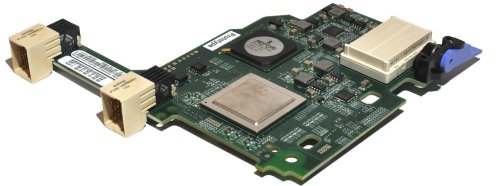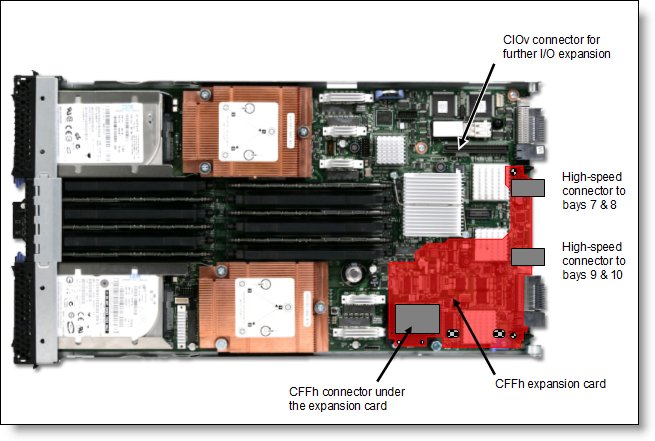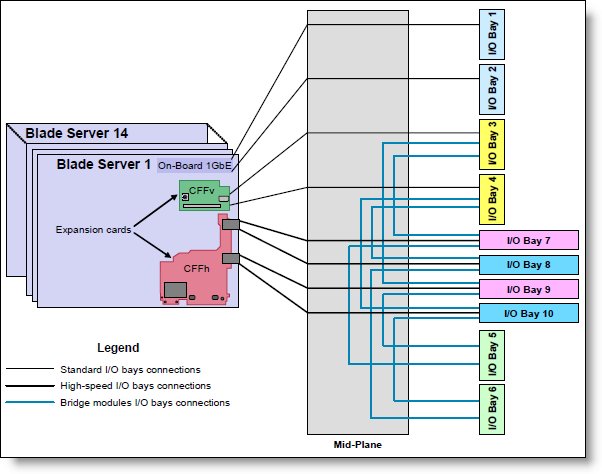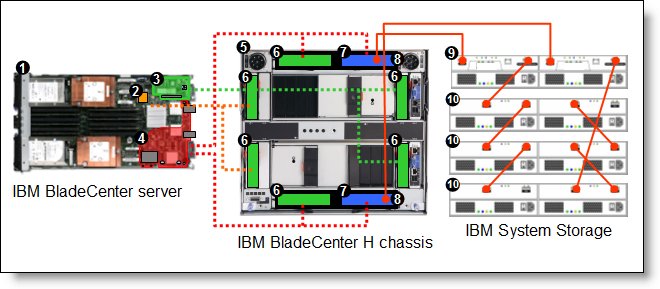Abstract
The QLogic Ethernet and 8 Gb Fibre Channel Expansion Card (CFFh) for BladeCenter is installed in the blade server and allows connectivity to high-speed switch bays. This expansion card provides flexibility for connecting the blade server to the horizontally oriented BladeCenter H modules in bays 7 and 8 or bays 9 and 10 when using the Multi-Switch Interconnect Module (MSIM).
Withdrawn from marketing: QLogic Ethernet and 8 Gb Fibre Channel Expansion Card (CFFh) is withdrawn from marketing.
Introduction
The QLogic Ethernet and 8 Gb Fibre Channel Expansion Card (CFFh) for BladeCenter is installed in the blade server and allows connectivity to high-speed switch bays. This expansion card provides flexibility for connecting the blade server to the horizontally oriented BladeCenter H modules in bays 7 and 8 or bays 9 and 10 when using the Multi-Switch Interconnect Module (MSIM).
Figure 1 shows the QLogic Ethernet and 8 Gb Fibre Channel Expansion Card (CFFh).

Figure 1. QLogic Ethernet and 8 Gb Fibre Channel Expansion Card (CFFh)
Did you know?
Installing the QLogic Ethernet and 8 Gb Fibre Channel Expansion Card (CFFh) card in every blade server in your chassis adds two 1 Gb Ethernet ports and two 8 Gb Fibre Channel ports to each server. Combined with the two onboard Ethernet ports, this gives you an aggregate total of 4 Gbps of Ethernet bandwidth and 16 Gb of Fibre Channel bandwidth for every server in the chassis. This has the potential of meeting even the most bandwidth-intensive application needs such as virtualization.
When using the CFFh adapter, you can simultaneously use a CFFv or CIOv adapter to enable additional I/O support to blade servers such as the HS22 when installed in the BladeCenter H chassis. The innovative design of the CFFh adapter is designed to work with the CFFv or CIOv adapter to support this combination workload.
The adapter connects to the midplane directly, without having to use cables or small form-factor pluggable (SFP) modules. By eliminating these components for up to 14 servers, the resulting savings alone covers the BladeCenter chassis investment.
Part number information
Table 1 shows the part number to order this card.
Table 1. Part number and feature code for ordering
| Description | Part number | Feature code (x-config / e-config) |
| QLogic Eth and 8Gb Fibre Channel Exp Card (CFFh) for BladeCenter | 44X1940* | 5485 / 8271 |
| QLogic Enet and 8Gb FC Exp Card (CFFh) for BladeCenter | 00Y3270* | A3JC / None |
* Withdrawn from marketing.
The part number includes the following items:
- One QLogic Ethernet and 8 Gb Fibre Channel Expansion Card (CFFh) for BladeCenter
- The documentation CD
- The Important Notices document
Features
The QLogic Ethernet and 8 Gb Fibre Channel Expansion Card (CFFh) has the following features:
- Specifications
- CFFh form factor
- PCI Express x8 host interface
- Broadcom 5709S ASIC with two 1 Gb Ethernet ports
- QLogic EP2532 ASIC with two 8 Gb Fibre Channel ports
- Two Gigabit Ethernet ports routed to the bays 7 and 9 of the MSIM
- Two 8 Gb Fibre Channel ports routed to the bays 8 and 10 of the MSIM
- Support for BladeCenter Open Fabric Manager
- Support for direct memory access (DMA)
- Ethernet features
- Full-duplex (FDX) capability, enabling simultaneous transmission and reception of data on the Ethernet local area network (LAN).
- Failover and load balancing NIC teaming support
- Preboot Execution Environment (PXE) support
- Fibre Channel features
- 8/4/2 Gbps speeds with auto-negotiation (4.2480/2.1240/1.0625 Gbps)
- 200,000 IOPS per port
- 1,600 MBps (full duplex) per port
- Fast!UTIL BIOS utility program to customize the configuration parameters
- Support for point-to-point fabric connection (F-port fabric login)
- Support for Fibre Channel Arbitrated Loop (FC-AL) connection (FL-port fabric login)
- Support for Fibre Channel service (classes 2 and 3)
- Multi-ID and Node port (N_Port) virtualization (NPV) allows a single port to acquire multiple N_Port IDs.
- Support for remote startup (boot) operations
- Persistent binding
- Logical unit number (LUN) masking
- Fibre Channel standard compliance
- SCSI-3 Fibre Channel Protocol (SCSI-FCP)
- Fibre Channel Protocol for SCSI, Second Version (FCP-2)
- Fibre Channel Physical and Signaling Interface (FC-PH, FC-PH-2, FC-PH-3)
- Fibre Channel Arbitrated Loop (FC-AL, FC-AL-2)
- Fibre Channel Fabric Loop Attachment (FC-FLA)
- Fibre Channel Private Loop Direct Attach (FC-PLDA)
- Fibre Channel Tape (FC-TAPE)
- Fibre Channel Generic Services (FC-GS-2, FC-GS-3)
- Fibre Channel Framing and Signaling (FC-FS)
Operating environment
The expansion card is supported in the following environment:
- Temperature: 10 to 35°C (50 to 95°F)
- Relative humidity: 8% to 80% non-condensing
Supported servers and I/O modules
The QLogic Ethernet and 8 Gb Fibre Channel Expansion Card (CFFh) is supported in the BladeCenter servers listed in Table 2.
Table 2. Supported servers
| Part number |
Product description | ||||||||
|---|---|---|---|---|---|---|---|---|---|
| 44X1940 | QLogic Eth and 8Gb Fibre Channel Exp Card (CFFh) | Y | Y | Y | Y | Y | Y | Y | Y |
| 00Y3270 | QLogic Enet and 8Gb FC Exp Card (CFFh) | Y | Y | Y | Y | Y | Y | Y | Y |
See ServerProven at the following Web address for the latest information about the expansion cards supported by each blade server type:
http://ibm.com/servers/eserver/serverproven/compat/us/
Figure 2 shows where the CFFh card is installed in a BladeCenter server.

Figure 2. Location on the BladeCenter server planar where the CFFh card is installed
The QLogic Ethernet and 8 Gb FC Expansion Card is used in conjunction with the MSIM in BladeCenter H or MSIM-HT in BladeCenter HT. The card requires the following I/O modules in the MSIM:
- A supported Ethernet switch module or pass-thru module installed in the left bay (for the Ethernet connections)
- A supported Fibre Channel switch module or pass-thru module installed in the right bay (for the Fibre Channel connections)
Table 3 lists the I/O modules that can be used to connect to the QLogic Ethernet and 8 Gb Fibre Channel Expansion Card (CFFh).
Table 3. I/O modules supported with the QLogic Ethernet and 8 Gb FC Expansion Card (CFFh)
| I/O module | Part number |
MSIM
|
MSIM-HT
|
| Left bay of the MSIM (Ethernet) | |||
| Cisco Catalyst Switch Module 3110G | 41Y8523 | Y | Y |
| Cisco Catalyst Switch Module 3110G | 00Y3254 | Y | Y |
| Cisco Catalyst Switch Module 3110X | 41Y8522 | Y | Y |
| Cisco Catalyst Switch Module 3110X | 00Y3250 | Y | Y |
| Cisco Catalyst Switch Module 3012 | 43W4395 | Y | Y |
| Cisco Catalyst Switch Module 3012 | 46C9272 | Y | Y |
| Server Connectivity Module | 39Y9324 | Y | N |
| Layer 2/3 Copper Gb Ethernet Switch | 32R1860 | Y | Y |
| Layer 2/3 Fiber Gb Ethernet Switch | 32R1861 | Y | Y |
| Layer 2-7 Gb Ethernet Switch | 32R1859 | N | N |
| 1/10 Gb Uplink ESM | 44W4404 | Y | Y |
| Intelligent Copper Pass-thru Module | 44W4483 | Y | N |
| Right bay of the MSIM (Fibre Channel) | |||
| Brocade Enterprise 20-port 8Gb SAN Switch Module | 42C1828 | Y | N |
| Brocade 20-port 8Gb SAN Switch Module | 44X1920 | Y | Y |
| Brocade 10-port 8Gb SAN Switch Module | 44X1921 | Y | Y |
| Cisco Systems 4Gb 20 port Fibre Channel Switch | 39Y9280 | Y | Y |
| Cisco Systems 4Gb 20 port Fibre Channel Switch | 44E5696 | Y | Y |
| Cisco Systems 4Gb 10 port Fibre Channel Switch | 39Y9284 | Y | Y |
| Cisco Systems 4Gb 10 port Fibre Channel Switch | 44E5692 | Y | Y |
| QLogic 20-Port 8Gb SAN Switch Module | 44X1905 | Y | Y |
| QLogic 20-Port 4/8 Gb SAN Switch Module | 88Y6406 | Y | Y |
| QLogic 8Gb Intelligent Pass-thru Module | 44X1907 | Y | N |
| QLogic 4/8 Gb Intelligent Pass-thru Module | 88Y6410 | Y | N |
In the BladeCenter H, the ports of CFFh cards are routed through the midplane to I/O bays 7, 8, 9, and 10 as shown in Figure 3.

Figure 3. BladeCenter H I/O topology showing the I/O paths from the CFFh expansion cards
The BladeCenter H supports two MSIMs. The top MSIM is installed in the space occupied by I/O bays 7 and 8. The bottom MSIM is installed in the space occupied by bays 9 and 10. Figure 4 shows the MSIM being installed into bays 7 and 8 of the BladeCenter H chassis.

Figure 4. MSIM installed in bays 7 and 8 of the BladeCenter H chassis
To use both Ethernet ports and both Fibre Channel ports of the expansion card, you must install the following items:
- Two MSIMs in the BladeCenter H chassis
- One Ethernet switch module and one Fibre Channel switch module in each MSIM
Each switch module routes one port of the expansion card:
- CFFh port 1: upper-left MSIM bay 7 (Ethernet)
- CFFh port 2: upper-right MSIM bay 8 (Fibre Channel)
- CFFh port 3: lower-left MSIM bay 9 (Ethernet)
- CFFh port 4: lower-right MSIM bay 10 (Fibre Channel)
Popular configurations
The QLogic Ethernet and 8 Gb FC Expansion Card is ideal for adding additional Ethernet and Fibre Channel ports to a BladeCenter H configuration. In this configuration, each HS22 blade server has the QLogic expansion card installed along with an Ethernet Expansion Card (CIOv) and the onboard Ethernet controller. This means that six Ethernet connections and two Fibre Channel connections are delivered to each server (Figure 5). All connections between the cards and the switch modules are internal to the chassis. No cabling is needed.

Figure 5. Using the QLogic Ethernet and 8 Gb FC Expansion Card to supply six Ethernet connections and two Fibre Channel connections to each server
Table 4 lists the components that are used in this configuration.
Table 4. Components used in the eight ports-per-server configuration
| Diagram reference | Part number / machine type | Description | Quantity |
| 7870 | BladeCenter HS22 | 1 to 14 | |
| None | Ethernet controller on the system board of the server | 1 per server | |
| 44W4475 | Ethernet Expansion Card (CIOv) for BladeCenter | 1 per server | |
| 44X1940 | QLogic Ethernet and 8 Gb FC Expansion Card for BladeCenter | 1 per server | |
| 8852 | BladeCenter H chassis | 1 | |
| Varies | Ethernet Switch Modules routing signals from the integrated controller |
6 | |
| Varies | 8 Gb Fibre Channel Switch Modules (see Table 3) | 2 | |
| 39Y9314 | Multi-Switch Interconnect Module | 2 | |
| 1726-41X or 1726-42X | IBM System Storage DS3400 (Single or Dual Controller) | 1 | |
| 1727 | Optional: IBM System Storage EXP3000 (Single or Dual ESM) | 1 to 3 | |
| Not shown | 39R6536 | DS3000 Partition Expansion License | 1 |
Supported operating systems
The QLogic Ethernet and 8 Gb Fibre Channel Expansion Card (CFFh) supports the following operating systems:
- AIX 5L for POWER Version 5.3
- AIX Version 6.1
- IBM i 6.1
- IBM i 7.1
- IBM Virtual I/O Server
- Microsoft Windows Server 2003, Web Edition
- Microsoft Windows Server 2003/2003 R2, Enterprise Edition
- Microsoft Windows Server 2003/2003 R2, Enterprise x64 Edition
- Microsoft Windows Server 2003/2003 R2, Standard Edition
- Microsoft Windows Server 2003/2003 R2, Standard x64 Edition
- Microsoft Windows Small Business Server 2003/2003 R2 Premium Edition
- Microsoft Windows Small Business Server 2003/2003 R2 Standard Edition
- Microsoft Windows Server 2008, Enterprise x64 Edition
- Microsoft Windows Server 2008, Enterprise x86 Edition
- Microsoft Windows Server 2008, Standard x64 Edition
- Microsoft Windows Server 2008, Standard x86 Edition
- Microsoft Windows Server 2008, Web x64 Edition
- Microsoft Windows Server 2008, Web x86 Edition
- Microsoft Windows Server 2008 R2
- Microsoft Windows Server 2012
- Red Hat Enterprise Linux 4 AS for AMD64/EM64T
- Red Hat Enterprise Linux 4 AS for x86
- Red Hat Enterprise Linux 4 ES for AMD64/EM64T
- Red Hat Enterprise Linux 4 ES for x86
- Red Hat Enterprise Linux 4 WS/HPC for AMD64/EM64T
- Red Hat Enterprise Linux 4 WS/HPC for x86
- Red Hat Enterprise Linux 5 for IBM POWER
- Red Hat Enterprise Linux 5 Server Edition
- Red Hat Enterprise Linux 5 Server Edition with Xen
- Red Hat Enterprise Linux 5 Server with Xen x64 Edition
- Red Hat Enterprise Linux 5 Server x64 Edition
- Red Hat Enterprise Linux 6 Server Edition
- Red Hat Enterprise Linux 6 Server x64 Edition
- SUSE LINUX Enterprise Server 9 for AMD64/EM64T
- SUSE LINUX Enterprise Server 9 for x86
- SUSE LINUX Enterprise Server 10 for AMD64/EM64T
- SUSE LINUX Enterprise Server 10 for IBM POWER
- SUSE LINUX Enterprise Server 10 for x86
- SUSE LINUX Enterprise Server 10 with Xen for AMD64/EM64T
- SUSE LINUX Enterprise Server 10 with Xen for x86
- SUSE LINUX Enterprise Server 11 for AMD64/EM64T
- SUSE LINUX Enterprise Server 11 for x86
- SUSE LINUX Enterprise Server 11 with Xen for AMD64/EM64T
- VMware ESX 3.5
- VMware ESX 4.0
- VMware ESX 4.1
- VMware ESXi 4.0
- VMware ESXi 4.1
- VMware vSphere 5
- VMware vSphere 5.1
See ServerProven at the following address for the latest information about the specific versions and service packs that are supported for the particular blade server:
http://ibm.com/servers/eserver/serverproven/compat/us/
Select the blade server and then select the expansion card to see the supported operating systems.
Related product families
Product families related to this document are the following:
Trademarks
Lenovo and the Lenovo logo are trademarks or registered trademarks of Lenovo in the United States, other countries, or both. A current list of Lenovo trademarks is available on the Web at https://www.lenovo.com/us/en/legal/copytrade/.
The following terms are trademarks of Lenovo in the United States, other countries, or both:
Lenovo®
BladeCenter Interoperability Guide
BladeCenter Open Fabric
BladeCenter®
ServerProven®
The following terms are trademarks of other companies:
Linux® is the trademark of Linus Torvalds in the U.S. and other countries.
Microsoft®, Windows Server®, and Windows® are trademarks of Microsoft Corporation in the United States, other countries, or both.
Other company, product, or service names may be trademarks or service marks of others.
